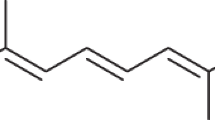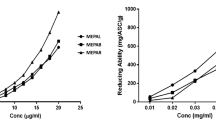Abstract
THE structure and properties of dehydroascorbic acid are to a certain extent similar to those of alloxan, and both the substances are diabetogenic in rats1,2. It was previously reported by Bhattacharya, Robson and Stewart3 that dehydroascorbic acid causes a precipitous but temporary fall in the reduced glutathione content of rat liver. Their results suggested that the fall in reduced glutathione was not due to oxidation but due to a complex formation between the sulphydryl group of glutathione and dehydroascorbic acid. Hexokinase is an enzyme the activity of which probably depends on the presence of free sulphydryl group(s)4,5. It seemed desirable, therefore, to study the effect of dehydroascorbic acid on the hexokinase activity of rat liver homogenate. Although Griffiths6 reported that cysteine is capable of releasing the inhibition of muscle hexokinase by alloxan, in view of the results obtained with dehydroascorbic acid it was decided to study the effect of alloxan and cysteine on liver hexokinase.
This is a preview of subscription content, access via your institution
Access options
Subscribe to this journal
Receive 51 print issues and online access
$199.00 per year
only $3.90 per issue
Buy this article
- Purchase on Springer Link
- Instant access to full article PDF
Prices may be subject to local taxes which are calculated during checkout
Similar content being viewed by others
References
Patterson, J. W., J. Biol. Chem., 183, 81 (1950).
Lazarow, A., Council for International Organizations of Medical Sciences Symposia on “Experimental Diabetes and its Relation to Clinical Diseases”, edit. by Delafresnaye, J. F., and Howard Smith, G., 49 (Blackwell Scientific Publications, Oxford, 1954).
Bhattacharya, S. K., Robson, J. S., and Stewart, C. P., Biochem. J., 62, 12 (1956).
Bailey, K., and Webb, E. C., Biochem. J., 42, 60 (1948).
Sols, A., and Crane, R. K., J. Biol. Chem., 206, 925 (1954).
Griffiths, M., Arch. Biochem., 20, 451 (1949).
Crane, R. K., and Sols, A., in “Methods in Enzymology”, edit. by Colowick, S. R., and Kaplan, N. O., 1, 277 (Academic Press, New York, 1955).
Author information
Authors and Affiliations
Rights and permissions
About this article
Cite this article
BHATTACHARYA, S. Inhibition of Liver Hexokinase by Dehydroascorbic Acid and Alloxan. Nature 184, 1638–1640 (1959). https://doi.org/10.1038/1841638b0
Issue Date:
DOI: https://doi.org/10.1038/1841638b0
Comments
By submitting a comment you agree to abide by our Terms and Community Guidelines. If you find something abusive or that does not comply with our terms or guidelines please flag it as inappropriate.



